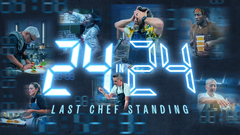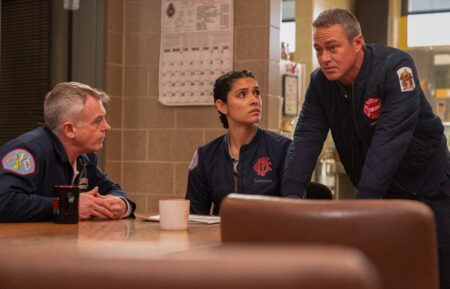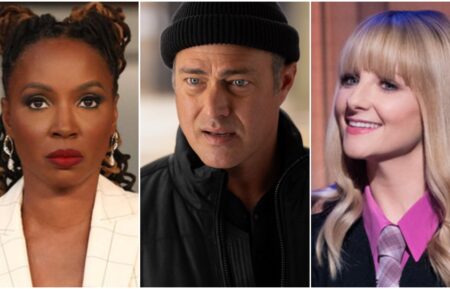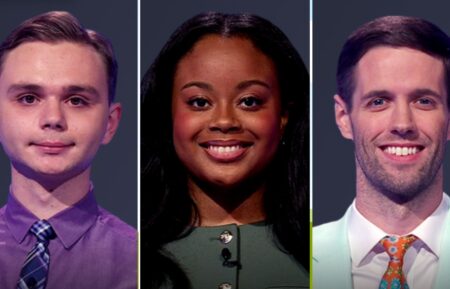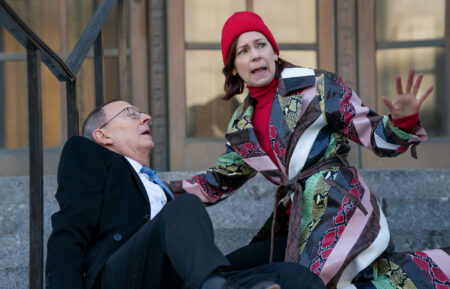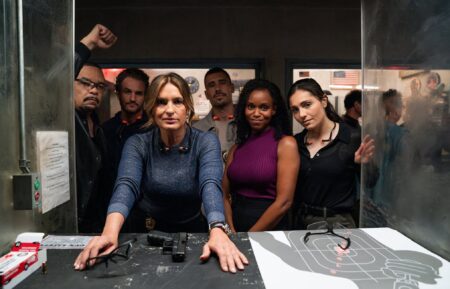’24 in 24: Last Chef Standing’: Michael Symon Talks TV’s Most Grueling Cooking Contest
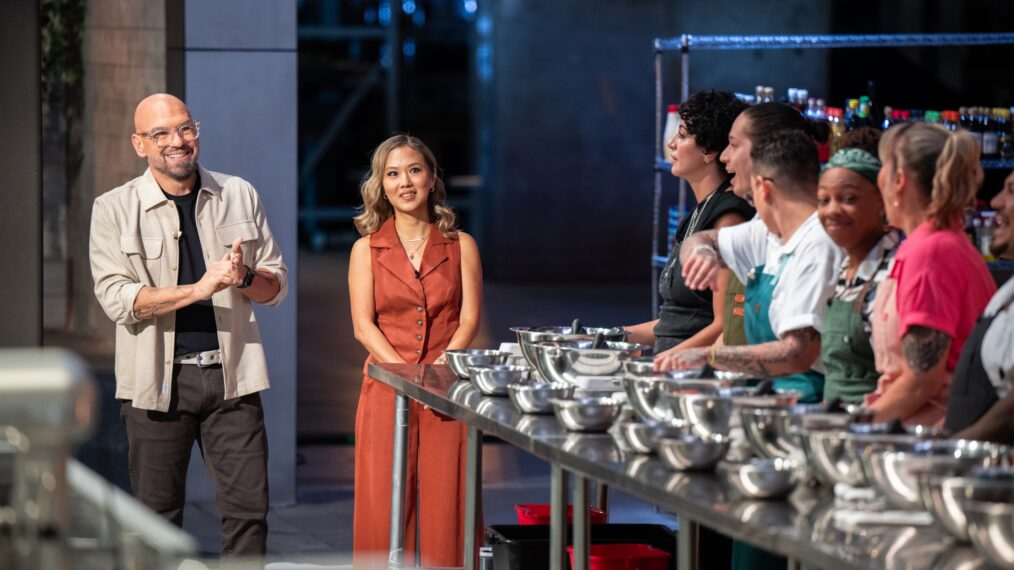
Exclusive
Don’t sleep on Season 2 of 24 in 24: Last Chef Standing. The Food Network competition series returns April 27 as hosts Michael Symon and Esther Choi welcome two dozen brave souls for another round of the ultimate culinary showdown. They’ll put their skill, creativity and stamina to the test with 24 challenges over the course of 24 straight hours. By the end, only one (surely exhausted) competitor will be left standing and $75,000 richer.
Challenges are broken down into eight shifts that are indicative of the demands of a chef on a daily basis. Focus centers on different skills including speed, resourcefulness, artistry and adaptability. Guest judges stop by to assess the participants, which are an impressive array of industry leaders, emerging talents and familiar Food Network staples. Twists and curve balls are also on the menu to further test the participants.
For a veteran like Symon, the concept is unlike anything he has seen. That’s saying something when you look at the chef, restaurateur, television personality and author’s impressive resume. The 55-year-old is known over the decades for everything from Iron Chef America to sitting on the panel of hosts on The Chew and being an overall regular presence on Food Network in numerous capacities. Ahead of the supersized premiere, we caught up with Symon to preview the pressure-cooker competition to come.
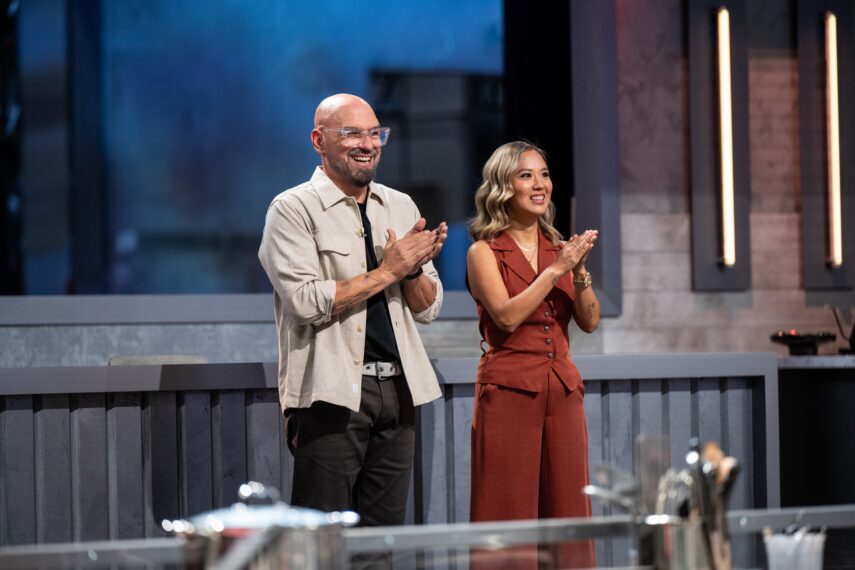
Hosts Michael Symon and Esther Choi, as seen on 24 in 24: Last Chef Standing, Season 2. (Food Network)
How do you reflect on the last season? Are you surprised there were 24 more wanted to participate after seeing the grueling gauntlet this was?
Michael Symon: When I first heard about it, I was very excited because this is truly how a chef’s life is. When you’re opening a restaurant or doing all those things as a chef, that’s kind of how our lives are. Most of the chefs doing this, especially ones who have opened restaurants in their career…I always say when [my wife] Liz [Shanahan] and I opened Lola we kind of slept in the restaurant basically for three days leading into opening and it was probably an hour at a time. If there has ever been a show that really is a true look into a chef’s life, this is the show. I feel the first year was harder to find the 24 chefs because people didn’t really know what they were getting into. Then once the show was on, I literally probably got 200 texts from chefs saying, “I want in.” They all wanted to do it because they do this all the time. It was an exciting show to shoot. I think it was the highest-rated freshman show for Food Network over five years. Obviously the viewers got into it too. It was just a really fun show. Exhausting, yes, but incredibly fun.
Take us behind the scenes. What is it like for you and Esther during the filming process? You also have the crew too. It’s like you’re going through it with them.
For Esther and I, we’re basically up for over 30 hours because we have to get there before the chefs. Because it is real-time and the clock doesn’t stop and there’s no real stopping. It’s not like any other TV show where you may shoot a segment, there is a stop down. You shoot another segment and the same thing. There is now stop downs. You’re going the whole time. There were three separate camera crews that rotated through every eight hours. Same with sound and all those things. For Esther and I, it was over 30 hours of being awake. Even in the first season, some of the production was like, “You can take a break.” I thought if the competitors were going through it, we’re going through it. We just stayed up with them.
What stands out in Season 2?
I think the first year we had incredible chefs. Season 2 though, the level of chefs was insanity, we just really had an incredible lineup of chefs. That I feel helps elevate things immediately. The other thing that happened was everyone doing Season 2 had seen Season 1, so they felt they knew what would happen next. That wasn’t the case. We mixed things up. We changed things up a bit for the competitions, just so they couldn’t walk in and go, “Now I do this. Now I do this.” Predict what would happen. It made the show very unpredictable.
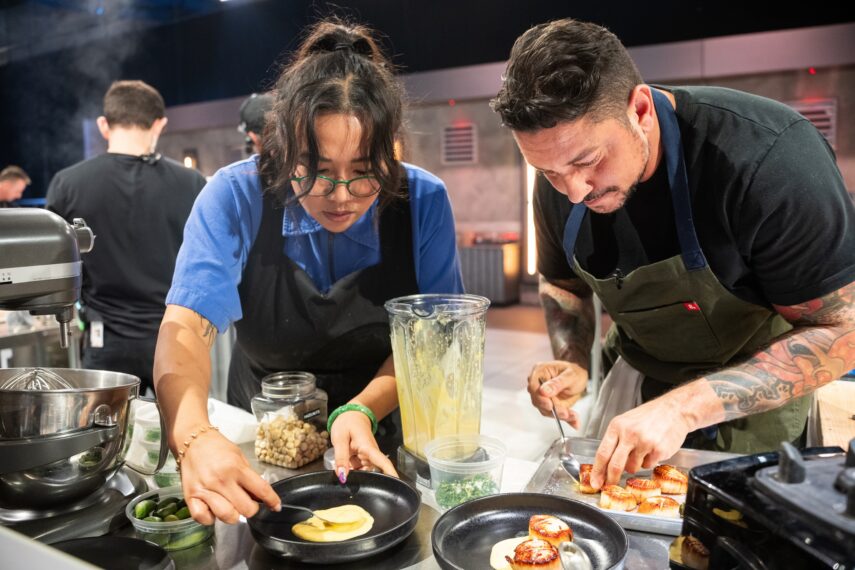
Chef Nini Nguyen and Chef Gabriele Bertaccini, as seen on 24 in 24: Last Chef Standing, Season 2. (Discovery Channel)
What can you tease in terms of what they will face this time around?
We had some similar challenges, but changed the order of things. I do some things to mess with them a little bit like pull some things that you’re accustomed to having on a daily basis. Now they need to take a breath and go, “Okay, what do I need to do here?” We sat down after Season 1 and thought, “Okay, what are the worst things that happened to us in the restaurant?” We’ve had a full restaurant and the power went out, a full restaurant when the hood system goes down, full restaurant and lose gas. These are all things that have happened in our careers at one point. Then it’s about how you respond . Fortunately, Liz and I were able to figure those things out when the restaurant down the street couldn’t. One succeeds and one fails in those crunch times. So, we try to sneak those things in there that were really real life restaurant tragedies that have happened to us throughout our careers. Things that we throw at them that have never happened before in a cooking competition or studio type situation.
What do you make of the competitor lineup?
They are just incredible. Some new faces people haven’t seen on Food Network before. Some faces they see regularly and ones they may have not seen for a long time. Bryan Voltaggio hasn’t competed for a long time. The fact he decided to do this is fantastic. Someone like Marc Murphy typically doesn’t do competitions like this. He threw his hat in the ring and said, “I have to show them the old guys can still do this.” I think there were a lot of those kinds of things. There were also those who people may not consider competition chefs. Someone like Damaris [Phillips], who people see more as a host than a chef so to speak. She threw her hat in the ring and got after it too. I think that makes it really fun.
I love that there are this variety of backgrounds and approaches.
The thing I love about a show like this is you can take the same chefs and have them go through this three times and every time you’re going to end up with a different winner. It comes down to who doesn’t have an off day, who’s not getting flustered. It’s literally that day. If you’re off that day, it’s a bad day to have an off day because there is no break in the action because it’s 24 straight hours. I think the beauty of the show is that because of its unpredictability. On paper you may think someone would make it to the final four and had a good chance at winning. Yet if they had a bad night’s sleep the day before or if they’re just off that day, it’s not going to be their day.

MARIO BATALI, JB SMOOVE, CARLA HALL, MICHAEL SYMON, CLINTON KELLY ( (Photo: Lorenzo Bevilaqua/ABC via Getty Images)
So many variables. What can you preview about the premiere with the focus on speed and Antonia Lofaso as the guest judge?
Antonia judging in the first episode is great because she is so battle tested and been through so many things. The judges are all chefs who have had tremendous amounts of success in the restaurant world and competing on television. Every one of them has said, “This is the hardest I’ve ever seen.” They almost question if they’d be able to do it. There is the reaction of the judges watching the whole thing happen, which I think is gold. The early competitions are really showing pure chef restaurant skills. Speed is a skill if you’re in the kitchen every day and grinding every day, you have to not only have to have a lot of finesse but be incredibly efficient. The chefs are able to show off those skills right away.
It gives you a really nice peak into who will do well in this competition. That’s always fun for the viewer to see. I’ve been doing Food Network since 1998 and I’ve never seen a show or competition situation that is shot in real-time with no breaks, no cuts, breaking the walls. You really get to see as you’re watching the show unfold a behind the scenes look at the show. There are no breaks. It’s almost like you’re watching two shows. You’re getting to watch it happen while also getting to see a behind the scenes look at how a show is shot. We don’t care if they catch a cameraman or someone has to run to the bathroom. We don’t care if you need to take a break. If you need to take a break, great. Just know the clock is not stopping. That’s your decision. You really get to see this insider look of what goes into a show and what goes into a show of this level.
You as a viewer definitely feel like a fly on the wall.
You are a fly on the wall! Exactly. Everyone who goes how they wish they could be a fly on the wall, here you go.
It’s crazy to think 10 years ago you and the rest of the hosts earned an Emmy for The Chew. How do you reflect on that time a decade later? Do you see that kind of format doing well today?
As everyone knows, I love cooking shows. I love to teach and cook. I always say there is always room for those shows. Winning the Emmy was incredibly flattering. Oddly enough, it also taught me a tremendous skill set that helped me a lot as host of this show because The Chew was also shot live. 24 in 24, although we’ve already shot it, the show was taped like a live show. For me as a host, being able to think on my feet quickly and just react to things naturally. There is no script or people telling you what to do next in your ear.
You just have to run the show so to speak. That benefited me greatly in hosting this show because I did live television for 1,500 episodes in seven years. That was something in my tool belt I was able to use. Then being an Iron Chef for a decade, that works very well watching this unfold too because I know what’s happening and on their minds. I’ve been there in competition. I do think a talk show format for cooking is great and would work. It was an experience I enjoyed very much and also helped prepare me to host a show like 24 in 24.
24 in 24: Last Chef Standing Season 2 premiere, April 27, 8/7c, Food Network (next day on Max)
